Intel Dual-Core Mobile Ivy Bridge Launch and i5-3427U Ultrabook Review
by Jarred Walton on May 31, 2012 12:01 AM EST- Posted in
- Laptops
- CPUs
- Intel
- Ivy Bridge
- Ultrabook
Ivy Bridge Ultrabook Battery Life and Thermals
So far, we’ve seen pretty much what we expected from Ivy Bridge Ultrabooks: moderately to slightly faster CPU performance compared to the first generation Ultrabooks, and a bigger step up in graphics performance. This matches up quite well with our experience of quad-core Ivy Bridge and the ASUS N56VM, but where things took a turn for the worse was in battery life. Many expected Ivy Bridge to be a significant step forward for laptop battery life, but at least on the N56VM we didn’t see that. What about ULV Ivy Bridge? Is it better, the same, or worse? Check out our results:
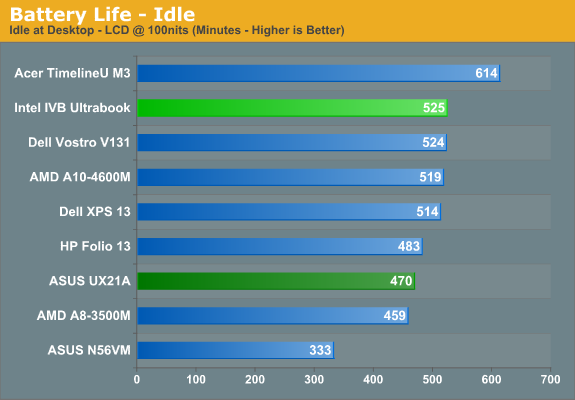
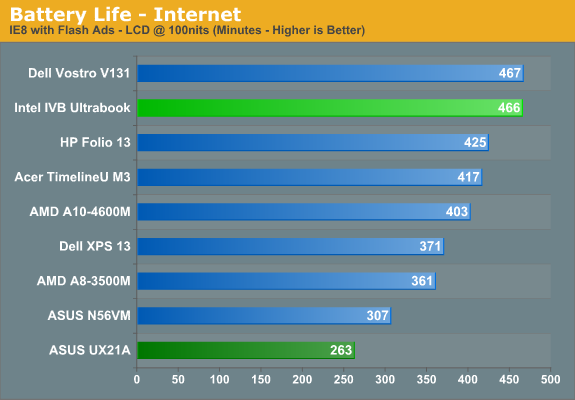
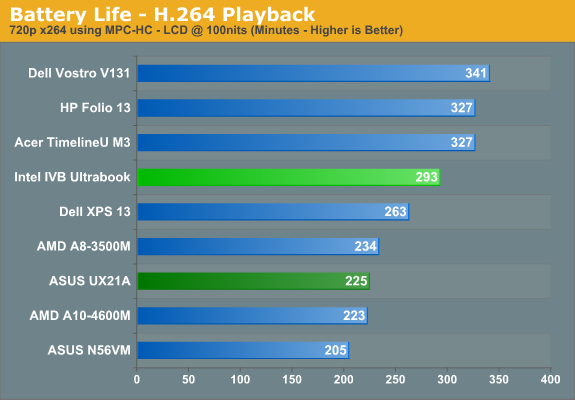
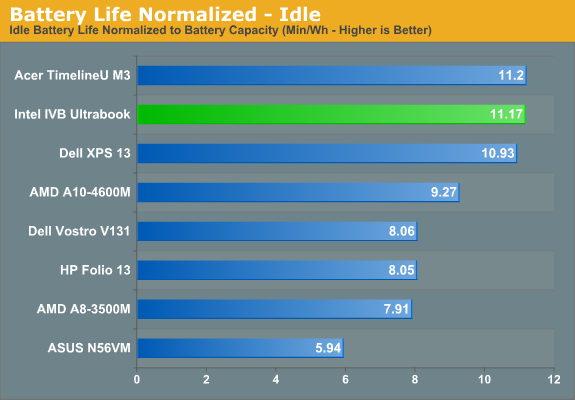
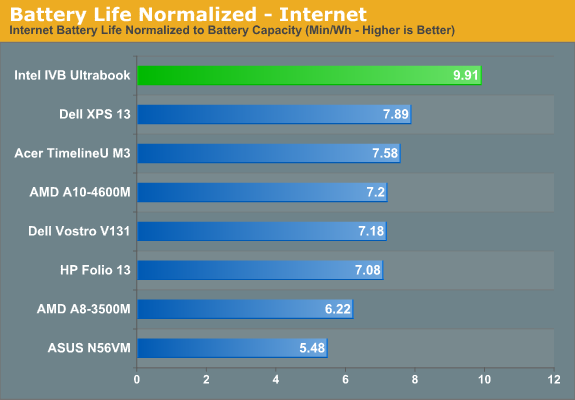
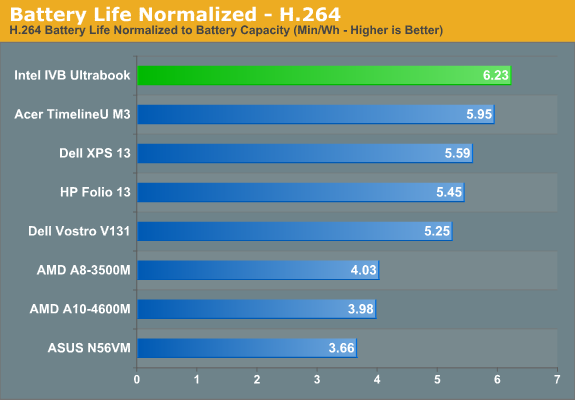
In terms of pure battery life, the Ivy Bridge prototype is good for nearly six hours of movie playback, close to eight hours of Internet surfing, and over 8.5 hours of idle time. It comes close to the top of our charts, though we could point out that the similar ASUS UX31E Sandy Bridge Ultrabook bests it in every category. Then again, ASUS has done very well in battery life comparisons for most of their laptops. Compared to the Acer S3, the IVB Ultrabook comes out ahead in Internet and behind in the other two disciplines; it does better against the Toshiba Portege Z830, Dell XPS 13, HP Folio 13, and matches or exceeds the Acer M3. Overall, given the improved performance, battery life looks to be similar or slightly better than Sandy Bridge Ultrabooks, which is quite acceptable.
We did run another battery life test looping 3DMark06 with the Balanced power profile and the IGP set to Balanced performance. Under those conditions, the PUB-RD Ultrabook lasted 107 minutes, which isn’t bad for that punishing workload.
As for thermals, this isn’t a production Ultrabook so these results aren’t particularly useful. Still, we ran our usual CPU+GPU stress test and here’s the HWMonitor screen capture:
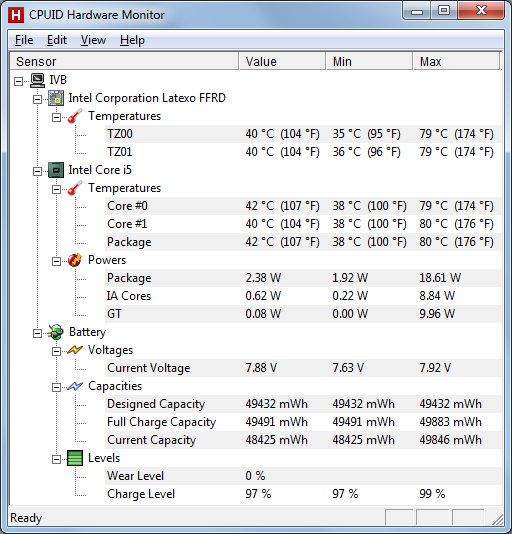
Thermals are reasonable under load at 79/80C, and most of that heat is right in the back-middle section of the chassis, so you’re not as apt to notice if you’ve got it resting on your lap. Along with the heat, let's quickly discuss acoustics.
The IVB Ultrabook is pretty much silent and registers well under the noise floor of our testing equipment during idle/light use, though the fan may occasionally spin up. Start running a few applications and depending on how hard they hit the CPU/GPU—and for how long—you’ll get a bump in noise to around 35dB. Under our stress test, which you’ll also get if you play any moderately demanding game or do some CPU intensive tasks, the Ultrabook becomes far more audible at 43dB. Again, given the not-for-resale nature of the system, it’s not something we’re particularly concerned with.

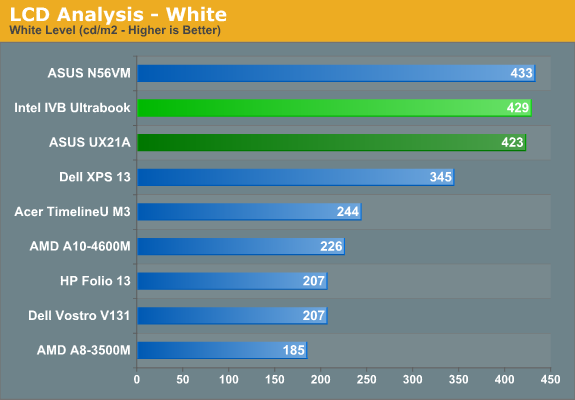
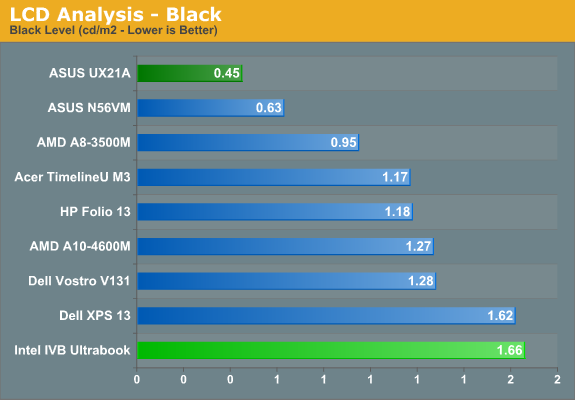
We’ve also run just a couple of the LCD tests; the LCD is the same one used in the ASUS UX31E, and the results are similar. You get a potentially bright LCD but with mediocre contrast and TN-quality viewing angles. Since this isn’t for sale, that’s perfectly acceptable, and given the choice between this panel and the 1366x768 junk so many Ultrabooks have shipped with, we'd definitely take this as an upgrade.










64 Comments
View All Comments
Ryan Smith - Thursday, May 31, 2012 - link
Price.ZeDestructor - Thursday, May 31, 2012 - link
And what's the difference in price? I shouldn't think its that much a big difference in between the two compared to, say, the CPU cost...JarredWalton - Thursday, May 31, 2012 - link
The chart we put together didn't include this information, but QS77 is targeted at SFF systems, so it has slightly lower power characteristics and it comes in a 22x22mm package instead of the 25x25mm packaging used on the other chipsets. Interestingly, even UM77 is 25x25mm, and that seems like the perfect chipset to have a smaller footprint.JarredWalton - Thursday, May 31, 2012 - link
Oh, nevermind: it's there. You just need to look for it.ZeDestructor - Thursday, May 31, 2012 - link
Still no price info though, I had to go Google it up :(QS77 is USD53 vs QM77 which is USD48.
To me eating 5$ worth of profit to gain some battery life is worth it, and also allows for smaller board designs. Once you factor in economies of scale, I don't see why the QS77 can't lose at least a further USD2 if the QM77 is cut out entirely and become even better value.
Source: http://laptoport.com/2011/12/28/intel-will-unveil-...
Its a good chart, just needs a price line ;)
JarredWalton - Thursday, May 31, 2012 - link
Intel didn't release pricing information, so I'd have to go to other sources to see what Intel has said in the past. Of course, it's basically meaningless to talk about chipset prices as the only people buying chipsets are the OEMs and motherboard manufacturers. Sadly, those are the same folks that will save $10 in most cases to ship a crappy LCD in place of something much better.thunderising - Thursday, May 31, 2012 - link
Wow, even with HD4000, IVB dual cores perform terribly in games.And even now, I'm pretty sure these are priced wayy above the old and new Llano Parts.
I give my vote to AMD's Trinity this round
JarredWalton - Thursday, May 31, 2012 - link
Don't jump ahead of the data: Dual-core Ivy Bridge ULV parts have generally weak performance in graphics. In a 17W TDP, it's very likely the maximum GPU clocks are not coming anywhere near 1150MHz on some titles. I suspect the standard voltage parts will be withing 5-10% of the quad-core parts for HD 4000 performance.As for AMD, their ULV/LV parts take some major GPU performance cuts as well. The A10-4655M will have GPU clocks that are 30% lower than the A10-4600M, while the A6-4455M has lower clocks and half as many Radeon cores. Given how far the A6 is cut back to fit in a 17W TDP, I don't expect it to fare much better on games.
ananduser - Thursday, May 31, 2012 - link
Well let's wait for a review first shall we ? :)JarredWalton - Thursday, May 31, 2012 - link
Sure, before we make any final statements, but based on the clocks and core counts we can certainly make a pretty good guess of where Trinity will rank with LV/ULV configurations. It's sort of like Brazos in that aspect, which is to say cutting the GPU or CPU down that far isn't going to help performance. On the compute side, though, funny things happen and compute doesn't always scale directly with core counts and clock speeds. Heck, look at the i5-3470 review from Anand: HD 2500 is sometimes 1/3 the performance of HD 4000. Ouch.Anyway, let's make some wagers. My guess on A6-4455M is that it will be about half as fast as the A10-4600M in games, while delivering about 80% of the single-threaded performance and less than half of the multi-threaded performance. The A10-4655M should do better, but it will probably still be 20-25% slower than A10-4600M for games, maybe 90% of the single-threaded performance, and 80% of the multi-threaded performance.